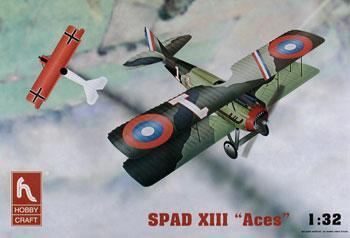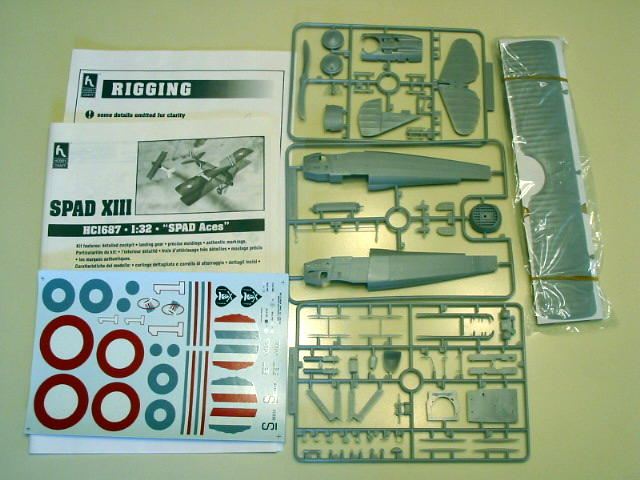
|
KIT: |
Hobbycraft 1/32 Spad XIII 'Aces' |
|
KIT # |
HC 1647 |
|
PRICE: |
$20 MSRP |
|
DECALS: |
Two options |
|
REVIEWER: |
Bill Michaels |
|
NOTES: |

|
HISTORY |
The SPAD VII entered service in the late fall of 1916. The SPAD VII was powered by a 150HP Hispano-Suiza engine, and was armed with a single Vickers gun. The SPAD VII was well-liked by its pilots, and it was considered to be a tough, well designed fighter.
As good as the SPAD VII was, it was found to be not as fast as some contemporary German fighters. A report at the end of 1917 said that the SPAD was not as fast as the Halberstadt, and that more power was needed. This was partially met by putting the newer 180HP Hispano-Suiza powerplant in the SPAD VII.
During the spring of 1917, the prototypes of the SPAD XIII were being evaluated. The major improvements of the XIII over the VII were twin Vickers gun armament, and the use of the 200 HP engine. The aircraft went into production and began to arrive at units in the summer of 1917.
At first, the new geared engine was very unreliable. Fortunately, the SPAD VII remained in production until the bugs were worked out. By the end of 1917, the SPAD XIII had replaced the VII as the main fighter in the French Armee d’Air. The aircraft was also used in American, British, Belgian, and Italian squadrons. The USAS purchased more SPADs than any other type of fighter.
Early models of the SPAD XIII featured a rounded wingtip. However, early in the production of the fighter, the wingtip was changed to a blunter, more squared off design. (Apparently it was easier to manufacture.) The great majority of SPAD XIIIs were built with the blunt wingtips.
|
THE KIT |

This is a model of the mainstream SPAD XIII, with the blunt wingtips. As such, the modeler has a huge variety of options for colors and markings. HobbyCraft has released this model in a two boxings, with markings for famous aces. The other version of the kit (kit HC1668) is the “SPAD XIII International”, which comes with decals for one French and one Italian ace. The version of the kit being reviewed here includes markings for one American (Rickenbacker) and one French (Nungesser) ace.
The kit comes in sturdy corrugated cardboard box. The top of the box is adorned with somewhat simplistic art, with bright colors. (It reminds me of the graphics you’d see in an older flight simulator program.) The back of the box has nice full color profiles, showing the complete color scheme for the two aircraft the kit makes.
The kit consists of about 60 parts. The model is molded in light gray, with a small clear sprue with a windscreen. The moldings are OK, but not exceptional. There is no flash on the parts, but there are some ejection pin marks in places that will need to be cleaned up, such as on the insides of the landing gear legs. A couple of the pieces have some sink marks. The worst in my kit was the propeller—the hub detail is sunken in. There will be no way to repair this and preserve the detail—I’ll have to fill the concave depression, and then scratch build replacement hub detail.
The model’s proportions look right to me, but I didn’t have any 1/32 scale plans to really check the parts against. The basic shape of the parts looks good compared to the Aircam book, but you never can tell for sure until the model is assembled. However, a web search turned up a full–build review on the Roll Models web site for the “International” version of the kit, where the reviewer reported the parts matched well against the drawings. (That’s good enough for me!)
The fuselage consists of left and right halves. There are separate panels for the metal panels around the nose. The louvered vents are molded as louver-shaped bumps. The cockpit is made up from 14 pieces. There are parts for the floor, seat, flight controls, and instruments. There is some stringer and former detail on the inside of the fuselage pieces.
Each wing is molded as a single piece. I think the rib detail is way overdone—it suffers from the “peaks and valleys” molding that manufacturers seem to think is what a fabric covered aircraft should look like. There are a number of good pictures of SPADs in books. If you look at one, you’ll see that the only place where the rib really stands proud of the covering is along the trailing edge. Over the rest of the flying surfaces, the fabric is drum tight, with only a hint of the rib’s presence showing. In the case of this kit, the wings would benefit form a good sanding. This kit is similar to others I have previewed—the Minicraft 1/32 Sopwith Camel and Revell 1/32 F3F-3 come to mind as having similarly overdone rib detail.
The instructions are a 4 page booklet, with a separate sheet for the rigging diagram. They are a combination of pictorial and written instructions. A nice touch is that the instructions for mounting the cabane struts tell you to mount them at a 70 degree angle, which eliminates some guesswork. (I wish other kit makers would do this!)
The colors are called out on the back of the box with FS numbers, where appropriate. The instructions include a chart that translates to the colors to PollyScale, Humbrol, and Modelmaster paints. When a proper color is not available in the brand, an approximate match is identified as such. In some cases (esp. Humbrol) some of the colors are just not available, so they don’t appear in the chart.
The decal sheet is large, and well printed. The colors look good—the blue for the markings is French blue and not British blue. A nice touch is that the instruments are represented with two decals- background and lettering are contrasting colors. (black on white or vice versa.)
|
CONCLUSIONS |
Recommended. Overall, I like the kit. I like the sturdy package, the decals, and the design of the kit. The only drawbacks are the overdone rib detail, and the mis-molded part. (I contacted HC, and asked for a replacement part. The one they sent was just like the original.)
This looks like a good model for someone looking for a SPAD. In general, I wouldn’t recommend a SPAD as someone’s first WW1 kit, as there are two sets of wing struts on each side, with an accompanying increase in rigging. But, if you really wanted a SPAD as your first WW1 subject, this would be a good choice. The large scale should make it easier to mount and rig the top wing. (Of course HobbyCraft’s 1/32 Nieuport 17 would be even easier to rig!) This kit also could be a good starting point for a more experienced modeler, as there are a number of aftermarket detail sets available for 1/32 scale WW1 aircraft.
Review kit courtesy of the Cape Cod Scale Modelers Model Show kit raffle.
|
REFERENCES |
Aircam Aviation Series No. 9: SPAD Scouts SVII-SXIII, by J.M. Bruce.
If you would like your product reviewed fairly and quickly by a site that has over 200,000 visitors a month, please contact me or see other details in the Note to Contributors.